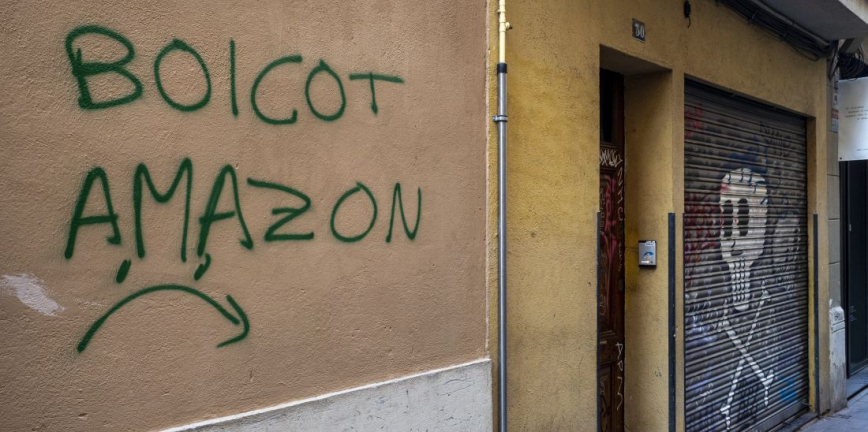Amazon, the super-termite
- Books
- Culture Folder
- Oct 22
- 7 mins

Fulfillment: America in the Shadow of Amazon is the result of a decade of research by journalist Alec MacGillis on the effects brought about by the multinational wherever it opens. Some devastating effects caused by Amazon, beyond the realm of work, in the urban, economic and environmental spheres, to name but a few. In a silent, but relentless manner, it acts like a super-termite eating away at the beams that have been holding up the world, to the point of making it so polarised and so precarious that even Millennials can’t stand it. If only politicians, when making it so easy for them to set up shop, and citizens, when placing orders, bore in mind everything that is explained in the book.
In the ravaged Baltimore we know from The Wire, where there was a gigantic General Motors (GM) factory, in September 2015, as a sign of the times, a 93,000-square-metre Amazon depot (the size of about 18 football fields), with a capacity for 1,900 trucks opened. GM paid workers $27 an hour; ten years later, the distribution giant paid its workers a miserly rate of 12 and 13 dollars per hour and even fewer social benefits. To set up, Jeff Bezos’ company had received 43 million dollars in state and local aid: public money to contribute to miserable wages…
The most disturbing thing about journalist Alec MacGillis’ book Fulfillment: In the Shadow of Amazon is not the chance to look into the filthy back room of the empire of the second richest man in the world ($171 billion). Although if only customers, when placing orders, bore in mind the details of what the book tells us: there are usually no chairs in the warehouses, although workers can walk up to 20 kilometres in a shift; they only have a 20-minute break in a ten-hour day, a separate lunch break: if they take longer, they accumulate demerit points, which are deducted from their salary and bring them closer to dismissal.
There is automated performance monitoring: a 15-metre truck has to be unloaded in 20 minutes. Inside, pallets have to be loaded at a rate of 13 per hour; the drivers must make 150 stops a day per shift, with the distribution of about a thousand packages a week… Some employees have come to be known as Amazombies because, to withstand the pace, they pop the Ibuprofen that Amazon sells them on-site in vending machines. Unsurprisingly, these warehouses experience twice as many accidents and serious injuries as the industry average in the United States.
But what most makes us shudder in the book are the devastating effects that, beyond the realm of work, Amazon causes in the urban, economic and environmental spheres, to name but a few. It is the silent, but relentless, effect of a super-termite eating away at the beams that have been holding up the world to the point of making it so polarised and so precarious that not even Millennials can stand it.
Amazon’s strategy is deadly simple: it presents itself to the authorities in the cities it has meticulously chosen with the promise of creating (or preserving, whichever bears a greater impact on those in government) so many thousands of jobs. The company then immediately suggests draconian tax exemptions and credits that, if not granted, carry the threat of setting up elsewhere, a potential location being explored that, in parallel, has also been disclosed to the public. The negotiations are secret, with intimidating confidentiality contracts.
The crazy bidding gets underway. If it weren’t for MacGillis’ rigour (68 interviews, 448 footnotes and a decade of work), some things would be hard to believe. In Akron (Ohio), the tax credits were extended up to 30 years: purchasing the plot of land is ultimately free for Amazon. The blackmail in Staten Island was huge: they would let the 5,000 workers join unions in exchange for permits and large subsidies for a new headquarters… It is no coincidence: the company has a department dedicated to procuring government aid that it calls the “Office for Economic Development”. It pays off: in 2019, it collected more than $2.7 billion in grants.
Bezos is also approaching Washington: politicians must be controlled to avoid getting their fingers burned in antitrust suits like the one Microsoft endured in 1998. Or to shut down regulations that prohibit the use of personal data from platforms. Aside from buying the influential newspaper The Washington Post, Amazon is the third-largest lobbyist in the United States, spending $16 million a year to convince Congress and the Administration to ditch e-sales taxes, drone regulation, the removal of discounts in their postal rates or to help them become the suppliers of major government departments and the CIA. The revolving doors also line their pockets: the government’s former Deputy Attorney General works in their offices and, until recently, the person in charge of materials procurement for the entire US Administration.
MacGillis interweaves the sociological evolution of cities (sometimes the most laborious part) with the development of companies and human-dimension stories; the resulting tapestry makes us outraged at the role of Amazon, which acts like woodworm. The pattern ends up becoming crystal-clear and, thus, wherever its mega-warehouses are located, the firm becomes a monopsony: being the only large workforce buyer, it increasingly brings salaries down, undermining livelihoods to infuriating extremes. So much so that, in five states, Amazon workers are among the foremost recipients of food stamps on account of their low earnings. The company even manages to get back part of the taxes paid by its workers to the Treasury, but, instead, it makes use of roads, special buses, hospitals, firefighters… Zero taxes; usufruct of the public, everything.
 Anti-Amazon graffiti on a street wall on Sant Pere Màrtir in the Gràcia neighbourhood. © Dani Codina
Anti-Amazon graffiti on a street wall on Sant Pere Màrtir in the Gràcia neighbourhood. © Dani CodinaIf the facilities are offices or data centres (which use the electricity of 5,000 households), the impact is just the opposite: rises of 11% in one year in housing prices just owing to the announcement of the company’s arrival (this is what happened in 2019 in Arlington, near the Federal Trade Commission and the Department of Justice in Washington, just as they were tackling Amazon’s market power); the call effect of high-level professionals (one in five of the capital’s inhabitants is already a university graduate compared to one in seven 12 years ago), attracted because other technology companies have also set up there; profiles that flood certain school districts and speed up the expulsion of former residents… Not to mention the impact in the economic sector (especially in the retail industry) or the socio-demographic upheaval, with territories increasingly polarised between those where these investments are concentrated and those that miss out on them; hyper-prosperity versus hyper-poverty, which protects against social tensions and a sociological scandal that turns electoral maps upside down.
Fulfillment: In the Shadow of Amazon should be a mandatory gift from political leaders to their technicians, and essential reading for every concerned citizen. Because what is explained in the book can already be sensed in our country. For example, in England they have now realised that Amazon, which already dominates e-commerce, is raising the prices of books, dramatically reducing the difference that existed until now with the prices in physical bookshops. BCN1, the company’s warehouse in the Catalan capital, employs 3,000 workers… and 6,000 robots, manufactured by a company that Amazon acquired to prevent competitors from benefiting from devices that move 400 items in an hour, four times more than other machines… As the subtitle of the book in Spanish reads, it is “the story of the future which lies before us”.
Fulfillment: America in the Shadow of Amazon
Alec MacGillis
Picador Paper, 2022
416 pages
The newsletter
Subscribe to our newsletter to keep up to date with Barcelona Metròpolis' new developments




